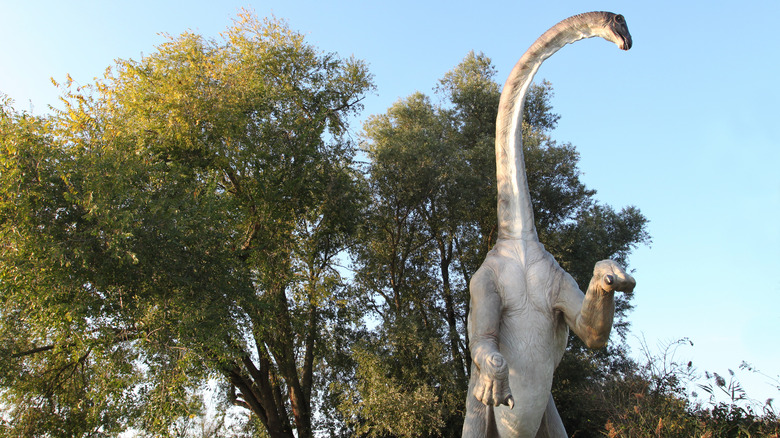One Portuguese Man's Backyard Was The Site Of An Incredible 48-Ton Discovery
A new dinosaur species was found in a man's backyard in Pombal, Portugal. The gigantic fossil now holds the record as the largest creature discovered so far in Europe. In 2017, the owner of the land spotted several fossilized bone fragments while he was doing construction work. He then contacted researchers at the University of Lisbon who began excavating the site. Between August 1 and August 10, Spanish and Portuguese paleontologists worked on the property, and their investigation yielded the remains of a 48-ton sauropod dinosaur that stood 39 feet high and 82 feet long, per EurekAlert.
The site dates back to the upper Jurassic period leading into the late Cretaceous, between 160 million to 100 million years ago. Researchers noted that the Pombal region has offered important finds from this period of time, with other prehistoric vertebrates (via CBS News). Portugal has a rich prehistory that involves fossils ranging from Allosaurus, a large theropod dinosaur, to brachiosaurus, another well-documented sauropod (via Natural History Museum London). As research continues the country, the recently unearthed remains will help breathe new life into its paleontological story.
Uncovering the biggest sauropod dinosaurs
The dinosaur uncovered in Pombal, Portugal belongs to the class known as the sauropods — large-bodied herbivores with long necks. The brachiosaurus was for a long time considered the largest of the sauropods and as such became the most recognizable name associated with them. Brachiosaurus could reach lengths of up to 98 feet and they, along with many other large species, were classified more specifically as titanosaurs. These creatures lumbered across the Earth between 163 million to 66 million years ago, when an asteroid impact led to a mass extinction at the end of the Cretaceous (via Britannica).
Back in 2014, scientists at Drexel University discovered the largest of the titanosaurs in Argentina when they found dreadnoughtus, a species that weighed in at 65 tons, according to Drexel News. But since then, Argentina's soil has exposed another sauropod that reigned as the largest land animal to have ever existed: Argentinosaurus, who reached 114 feet long (per Natural History Museum London). But the competition for largest or tallest animal keeps getting heated, with the discovery of a 121-foot Patagotitan, also from Argentina (via All That's Interesting), showing us that land animals were once as gargantuan as modern whales.
What this new find means for paleontology
While studies have yielded size estimates from femurs and other sparse remains, finding complete or near complete fossils is a rare prize in paleontology. For the Pombal researchers, the near complete skeleton of the sauropod is a boon for science. Elisabete Malafaia, a researcher at the University of Lisbon said that finding well-preserved ribs and otherwise intact remains in an undisturbed position is uncommon for sauropods found in Portugal (via EurekAlert).
So far, the exact species the specimen belongs to isn't completely known, but it is believed to be in the brachiosaurid family, of which brachiosaurus belongs. Malafaia told the press that the discovery is (via EurekAlert), "significant for the knowledge of the continental faunas that inhabited the Iberian Peninsula at about 145 million years ago." While the investigation is ongoing, ribs and vertebrae have been uncovered and has allowed researchers to infer the animal's record-breaking size. Scientists are optimistic that further excavations in the area will yield more complete skeletal remains (via EurekAlert).


